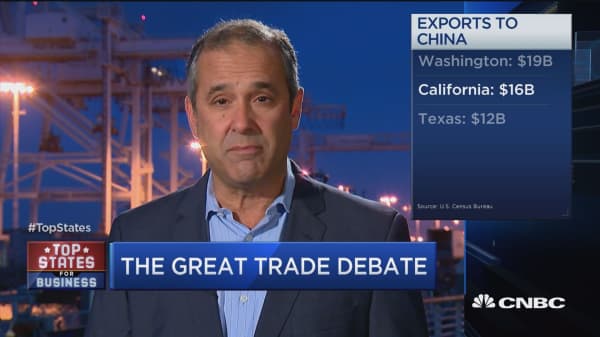In the United States, anti-free-trade sentiment has propelled real estate developer Donald Trump to the front of the GOP pack of presidential candidates, including a pledge to reverse the 1994 North American Free Trade Agreement with Canada and Mexico, the two top U.S. trade partners.
"We will either renegotiate it or we will break it," Trump said last fall, calling it "a disaster. Every agreement has an end. Every agreement has to be fair."
Trump has also vowed to raise tariffs on Mexico and China. Those higher tariffs would almost certainly cut into U.S. exports, which represent about $2 trillion, or roughly one-eighth of the nation's gross domestic product.
But that impact varies widely from one U.S. state to another, with West Coast states more heavily reliant on Chinese markets and border states seeing the biggest demand from Mexico.
China represents the third-largest U.S. export market, after Canada and Mexico, accounting for nearly $120 billion worth of goods last year. Overall, that represents less than 8 percent of U.S. exports — or less than 1 percent of total gross domestic product.
But the Chinese market is a much bigger deal for a handful of West Coast states.
Among the most dependent: Washington, which sold roughly 20 percent of its exports to China last year, or nearly $19 billion worth of goods. Airplanes, the state's largest export by far, made up the bulk of the state's sales to China.
California exports some $16 billion to mainland China, with computers and electronics accounting for more than a quarter of the total. Texas was the third-largest exporter to China, with more than $11 billion worth of products that included chemicals, computers and machinery.
Alaska, which exports a smaller volume of goods, sends $1.5 billion worth of its exports — a quarter of the total — to China. Roughly half of that consists of seafood.
U.S. farm states are also big exporters to China, which is the biggest single market for American agricultural products. Some 20 percent of all U.S. farm exports are sold to China, which bought $30 billion worth of food and other farm products in fiscal year 2014, including soybeans, distillers' grains, hides and skins, tree nuts, coarse grains, cotton and beef, according to the U.S. Department of Agriculture.




